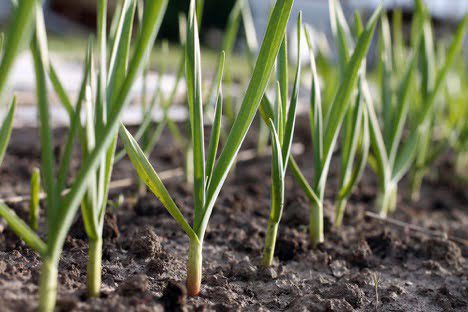How to Grow, Plant, Cure and Store Garlic
This as your complete guide on growing garlic, including how to plant garlic, when to plant, plant care including watering, curing garlic and storing garlic.
The two main types of Garlic are hardneck and softneck. In the northern areas, hardneck is the most commonly grown variety. And this is because they are more resilient in the cold weather. Softneck produces more cloves per head, but in colder climates, hardneck is the better choice. Hardneck varieties survive our tough winters, and store well once harvested. Hardscape varieties also produce garlic scapes, which not only look very cool but are also quite delicious.
What is Good About Garlic?
Garlic has a lot of benefits when ingested. It is used to treat many medical conditions. High blood pressure, heart disease, common cold, Alzheimer’s disease, and dementia are all bad guys that garlic can help kick their butts or keep out of your body. In addition to all of these, garlic is known to enhance athletic performance. Good for use with healthy eating programs like fasting, vegan diets, and more.
When you consider all these impressive benefits of the vegetable, you may wonder why you are not growing it yourself. The Garlic business is lucrative if you are growing it for sales.
You could also grow for personal use in your backyard garden. But if you live in Ontario, congratulate yourself. You are in one of the best places in the world to grow garlic. Do you doubt it? Here’s how.
Planting Garlic
Where to Get Garlic Heads to Plant
Start with the best quality garlic you can find. There are numerous sources of quality “seed” garlic such as reputable nurseries and garden catalogues. The organic garlic heads you buy at your local farmers’ market are also a good choice. Avoid planting – do not plant – the garlic you buy at your local supermarket. Most of it is imported from far away lands and has been chemically treated to ensure a long shelf life.
When to Plant Garlic
In Ontario, plant garlic from end of October to mid November up until ground freezes. Planting it too early in the fall could damage the shoots that grow before winter comes. Early planting might also encourage leaf growth which could kill the plant if nipped by a hard frost. And planting it too late in the fall would not give the roots enough time to develop before winter comes.
Garlic is a plant that needs both cold and warmth to germinate healthily throughout its growth life. The cold helps to build a stable root system while the warmth takes care of the above-ground growth.
Another critical thing to make sure of when planting garlic is the planting depth. Too shallow depth could lead to the early emergence of shoots. One last thing to make sure of is that you plant the cloves with the pointed side facing upwards. Otherwise, you might end up with deformed bulbs and curved shoots.
Refer to this chart for companion planting suggestions
This could be hard to ensure, however, if you use mechanical planting and you take these three precautions, you would be rewarded with rapid and healthy shoot growth when spring brings it warmth.
Furthermore, the garlic seed that you are preserving for planting should be left as a whole until some time before planting begins. This is because the cloves would dry out more quickly if you separated them from the bulb too early.
On an acre of farmland, you would need about 5000 to 9000 bulbs for maximum performance. And the cloves should be given 7 inches of space among one another in a row. If space was further widened, it could allow for the growth of larger bulbs while making weeding easy.
Planting Garlic Bulbils
Garlic bulbils can also germinate when planted. In fact, this is also a common practice in northern climates. This has its advantages and disadvantages. The major advantages are that the growers can quickly add to their planting stock, and that soil-borne diseases are far away from them.

Counting as a disadvantage against planting bulbils is that they take their time before they produce big, market sized garlic yield. They often take two or more years after planting to do so.
Furthermore, you should only extract bulbils from their capsules just before you plant them. Doing so long before you plant them could lead to the drying up of the bulbils, because of their small sizes and thin covers.
Take your head of “seed” garlic and separate into individual cloves. (This is known as “cracking the bulb”.) Choose the largest individual cloves and plant about 3” deep – pointy end up! – and about 4-6” apart. Water well. One clove will produce a whole head of garlic so you’ll need enough space for healthy bulb development. Cover with soil and a good layer of mulch. This will help protect your garlic during a nasty winter.
It is also important that they receive regular watering during their growing season as they would need it to help them develop robust root systems.
Planting Location and How to Prepare The Soil
The best place to plant garlic is where there is regular snow cover. This would keep the garlic protected from the onslaught of the cold above ground.
An area with excellent drainage is also advisable on heavy soil types. Another thing you want to avoid is planting garlic bulbs close to big trees or perennial weeds whose mature roots might hinder the garlic roots from properly developing.
When it comes to the soil types, garlic is not very picky. It can grow on a good number of soil types that support vegetable plant growth. But soils with remarkable organic matter content are perfect for garlic growing.
This is because this soil type retains moisture and nutrients better than other soil types. The problem with planting garlic on heavy soil types is that when they are wet, they could hinder the proper growth of the plant. Loose or sandy soil, on the other far end, does not have enough moisture-holding capacity.
Active Growth
In spring you will see young shoots poking through the mulch. This is a good time to sprinkle on an organic fertilizer. Fertilize again about a month later. Water during dry spells. In early summer hardneck varieties will produce scapes. Cut these off to encourage maximum bulb development, but don’t throw them away! There are many recipes that use these delicious scapes
Fertilizing the soil is also a nice option. And when you want to fertilize the soil, make sure you take a soil test to be sure of the nutrient level in the soil. This is because overloading the soil with nutrients it doesn’t need is not always a good idea.
Weed Management
Garlic plants don’t like to share their soil with other plants, especially weeds. That is why it is necessary to control the weed growth around them.
Pests and Diseases
Garlic plants, like many other plants, have pests and diseases that are always on the horizon to plague them. These pests and diseases could significantly reduce yields if they are not controlled.
Some of these intruders include bulb and stem nematodes, white rot, Penicillium mold, leek moth, and Fusarium basal plate rot. Controlling these pests is synonymous with increasing your yields.
Irrigation
Garlic requires adequate moisture for proper growth else the harvest could all be small garlic bulbs. When you grow the vegetable on clay or loam soil, you need about an inch of water per week during the growing season.
And you need double that amount or even more during the dry season. Irrigation is best done in the morning or afternoon so that the plant foliage dries up before cooler evening temperatures set in.
Removing the Scape
When you don’t remove the scapes of hardneck garlic, studies show that the bulb size could reduce by 30%. The reason the bulb size reduces is that more energy goes into growing bulbils instead of increasing the size of the bulb.
So, for this reason, remove the scapes when the bulbs have grown into big sizes. To remove scapes, you can easily snap them or cut them off while they are still in curls.
Harvesting Your Garlic
From late spring to summer, garlic continues to grow. What you want to avoid is harvesting it before it grows into its maximum size. The best time to harvest the plant is when 30% to 50% of the leaves have died. Gently pry the bulbs loose using a garden fork, being careful to not damage the bulbs.
You also want to harvest it in time before the wrapper leaves get stained. If you planted garlic on a small scale, in your garden, for instance, you can harvest it with your hands.
You can harvest bulbils by cutting off the scapes just before you harvest the real onion garlic bulbs.
Curing Your Garlic
Now that you have your yields, there is more work to do. To enhance the storage life of the garlic bulbs, dry them.

The key to successful bulb storage is curing. Simply hang the freshly harvested bulbs in a cool, dark space, or on a rack, with good air circulation for a few weeks. Once properly cured, clean the excess soil from the bulb and trim away the stems. Your heads of garlic should keep for months in a cool, dark space.
Also, arrange them in such a way that bulbs are covered by leaves from other rows. Doing this protects the bulbs from the onslaught of direct sunlight. The curing process can also be done indoors in well-ventilated areas.
Storing Your Garlic
Storing garlic is not a hard process. All you have to do is store the ones you want to consume as food at a temperature range of 0°C to 4°C and with a 60% to 70% relative humidity. If stored in places of high humidity, the bulbs could start developing roots, which isn’t what you want.
Garlic intended for replanting should be kept between 10°C and 21°C and within 60% to 70% relative humidity. At room temperature, you can store hardneck garlic for up to 4 months and softneck garlic for longer (10 months).
There are refrigerators that have humidity controls. If you use one of these, hardneck garlic can last for up to 10 years in them and softneck garlic can last for over a year.
Conclusion
The many remarkable benefits of garlic make it easy for many to embrace it. And of all its uses, its weight loss uses are one of the most popular. So if you need garlic for weight loss purposes, or for any of its other uses, and you want to plant it, you should now have no problems doing that.
About Emma Houston

Emma is a gardener, a bookkeeper, writer, and mother of three. She is spending her time mostly in her garden. When she is not there, you will find her working on developing her own line of homemade natural skincare products.







Leave a Reply
You must be logged in to post a comment.